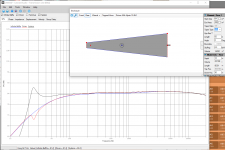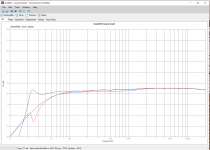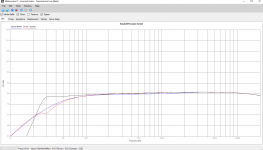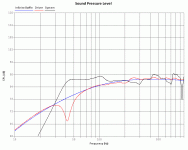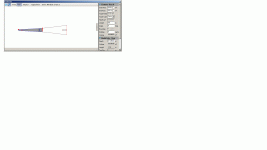I experimented with both in the program and found that having the wider mouth at the beginning of the port gave a better graph shape (lower reach and closer to flat). I may end up just making something out of wood to avoid any issues with the irregular shape (and expense) of the pvc Y.
I haven't accounted for the port from the floor. If I go with the traditional metronome having the port on the bottom and the metronome raised slightly above the ground.
I haven't accounted for the port from the floor. If I go with the traditional metronome having the port on the bottom and the metronome raised slightly above the ground.
Last edited:
OK, at a glance you might as well seal it up unless you add up to 8 ohms of series resistance to 'fill' the cab up [increasing Qts, trading efficiency for a flatter bandwidth], so click on the 'amplifier' link and try different resistor values in 'Rg' to see how it changes the response.
If this much resistance isn't acceptable, then you'll either need to tune the cab higher and/or make it smaller and/or increase stuffing density to get rid of the peaking at Fb.
GM
If this much resistance isn't acceptable, then you'll either need to tune the cab higher and/or make it smaller and/or increase stuffing density to get rid of the peaking at Fb.
GM
I gathered that. I doubt the efficiency loss will be that bothersome given the size of my room and normal listening volume preferences. I was curious if there are any other drawbacks to account for.
Just to be clear, since the driver is rated for 30w @ ~8ohm, would that mean it could still do 30w w/the 16ohm total load from an 8ohm series resister or would the driver be limited to 15w? My suspicion is the former since IIRC the w rating is more a factor of the driver's ability to handle the extra heat from more power. In that case the volume wouldn't be limited by the series resister I just would need a more powerful amp--one that could put 30w into 16ohm (for those times I wanted to get my students to leave in a hurry )
)
Just to be clear, since the driver is rated for 30w @ ~8ohm, would that mean it could still do 30w w/the 16ohm total load from an 8ohm series resister or would the driver be limited to 15w? My suspicion is the former since IIRC the w rating is more a factor of the driver's ability to handle the extra heat from more power. In that case the volume wouldn't be limited by the series resister I just would need a more powerful amp--one that could put 30w into 16ohm (for those times I wanted to get my students to leave in a hurry
Other than the possible effect on "damping" factor - perhaps more of an issue with some tube amps, and the need to rotate the dial a little further for required listening levels, you'll probably not notice a significant difference.
A 2 or 3 watt SET might struggle to deliver what you need, but anything over 20W - either a P/P tube or your favorite flavor of SS should be fine.
A 2 or 3 watt SET might struggle to deliver what you need, but anything over 20W - either a P/P tube or your favorite flavor of SS should be fine.
I doubt the efficiency loss will be that bothersome given the size of my room and normal listening volume preferences. I was curious if there are any other drawbacks to account for.
Shouldn't assuming a typical SS amp, power loss will vary with frequency [mostly down low]: https://web.archive.org/web/2016073...ping-Factor-and-Damn-Nonsense-Floyd-Toole.pdf
GM
Metronome Design 2.0: "The Simple Giant"
Start Area: 64"
End Area: 288"
Length 82"
Stuffing .3lb/ft3
Driver pos: 36" (~48" off the ground)
(Think ~8x8" at the top and 12x24" at the bottom)
Mass loaded w/12"^2 opening 3" long (essentially a 3" length of 4" pvc pipe)
I've included graphs of the alpair 10.3m and the 12p (I have both). 10.3 uses additional 4ohm series, 12p uses +8ohm series. The flatter response is 12p. Both showing 1w output.
The peak for both is at 25hz. I'm hoping that is low enough to be below any orchestral notes which afaik bottom out at 27.5hz which is about +2db for the 10.3m and about -1db for the 12p
Start Area: 64"
End Area: 288"
Length 82"
Stuffing .3lb/ft3
Driver pos: 36" (~48" off the ground)
(Think ~8x8" at the top and 12x24" at the bottom)
Mass loaded w/12"^2 opening 3" long (essentially a 3" length of 4" pvc pipe)
I've included graphs of the alpair 10.3m and the 12p (I have both). 10.3 uses additional 4ohm series, 12p uses +8ohm series. The flatter response is 12p. Both showing 1w output.
The peak for both is at 25hz. I'm hoping that is low enough to be below any orchestral notes which afaik bottom out at 27.5hz which is about +2db for the 10.3m and about -1db for the 12p
Attachments
Last edited:
Metronome Design 2.0: "The Simple Giant"
Start Area: 64"
End Area: 288"
Length 82"
Stuffing .3lb/ft3
Driver pos: 36" (~48" off the ground)
(Think ~8x8" at the top and 12x24" at the bottom)
Mass loaded w/12"^2 opening 3" long (essentially a 3" length of 4" pvc pipe)
I've included graphs of the alpair 10.3m and the 12p (I have both). 10.3 uses additional 4ohm series, 12p uses +8ohm series. The flatter response is 12p. Both showing 1w output.
The peak for both is at 25hz. I'm hoping that is low enough to be below any orchestral notes which afaik bottom out at 27.5hz which is about +2db for the 10.3m and about -1db for the 12p
Just a quick question: If you are not aiming for maximum bass extension, why are you then tuning your enclosure so low and having to put up with all kinds of compromises like loss of efficiency due to additional resistance, loss of cone excursion control, loss of bass quality?
If I were you, I would try to aim for as flat a response as possible before the knee in the response.
And remember to fudge room gain into your response, this could easily lift your bass response an extra 3-6db in the lower octaves.
Just a quick question: If you are not aiming for maximum bass extension, why are you then tuning your enclosure so low and having to put up with all kinds of compromises like loss of efficiency due to additional resistance, loss of cone excursion control, loss of bass quality?
Right now I am aiming for max bass extension for 2 reasons. 1) because 90% of what will play on this cabinet is symphonic music which needs to be able to go that low. Standard double bass without extension goes to E1 (41.2hz), and most modern basses have the C extension (goes down to C1 @32.7hz). Bass Trombone and Tuba often hit a low Bb at 29hz, and the piano goes to A0 at 27.5hz. I don't currently have the budget to add a subwoofer, hence why I'm hoping to get as much bass extension as possible. 2) step one is to see what is possible without too many compromises; step two is to find a happy balance among overall sound quality, monster/aesthetics, bass extension, and any other compromises.
compromises like loss of efficiency due to additional resistance, loss of cone excursion control, loss of bass quality?
Mild loss in efficiency doesn't bother me since the room is enclosed and I generally do not listen to loud music anyway.
You're the first to mention anything of loss of cone excursion control or loss of bass quality. Could you explain what causes these drawbacks and how they are modeled in the software?
And remember to fudge room gain into your response, this could easily lift your bass response an extra 3-6db in the lower octaves.
Good to know. What range is a good rule of thumb? The room this will go in has been treated with acoustical panels and is a relatively dry room. How is that likely to affect that fudge factor?
If I were you, I would try to aim for as flat a response as possible before the knee in the response.
Am going for flat + extension. Attached is the graph for the version I mentioned with half the starting and ending area. How's this for flat?
Attachments
Last edited:
My A10.3M Met Design
OK, I have been working on this too! My strawman design: 2"x4" top, 7"x9" bottom, 72" line length, 3"ID x 4" vent, driver 28" down from top, only top half stuffed.
My goal is to reproduce the lowest note of double bass, 41hz. This is above the FS of the driver, 38.3hz. Any thoughts?
OK, I have been working on this too! My strawman design: 2"x4" top, 7"x9" bottom, 72" line length, 3"ID x 4" vent, driver 28" down from top, only top half stuffed.
My goal is to reproduce the lowest note of double bass, 41hz. This is above the FS of the driver, 38.3hz. Any thoughts?
Attachments
OK, at a glance you might as well seal it up unless you add up to 8 ohms of series resistance to 'fill' the cab up [increasing Qts, trading efficiency for a flatter bandwidth], so click on the 'amplifier' link and try different resistor values in 'Rg' to see how it changes the response.
If this much resistance isn't acceptable, then you'll either need to tune the cab higher and/or make it smaller and/or increase stuffing density to get rid of the peaking at Fb.
GM
What kind of resistor should I add?
Concerning loss of cone excursion control, you have to bear in mind that below the system's tuning frequency, the box stops controlling the cone's excursion which would lead to "unloading" resulting in wild cone excursion and the driver hitting xmax at very low power levels.
I am not familiar with Leonard Audio but I could ultimately model your system in Martin King's worksheets (hopefully over the weekend) and show you the excursion vs freq graph.
A hump in lowest octave response will lead to what people call "one note bass", which is an exaggerated response around the lowest frequency the system will play.
If your aim is to cover the lowermost octave, yet retaining headroom and quality, you might just be asking the driver to do things it just can't do.
My take on such a system would be to tune the box close the driver's Fs and aim for a flat frequency response. I would even go as far as trying to avoid any saddle shape in the response before the drop.
And remember f(-10) is a much better indicator than f(-3) when it comes to the audibility of the response; f(-10) is where music energy is perceived as being half as loud whereas f(-3) is barely audible.
Hope it helps.
Nick
I am not familiar with Leonard Audio but I could ultimately model your system in Martin King's worksheets (hopefully over the weekend) and show you the excursion vs freq graph.
A hump in lowest octave response will lead to what people call "one note bass", which is an exaggerated response around the lowest frequency the system will play.
If your aim is to cover the lowermost octave, yet retaining headroom and quality, you might just be asking the driver to do things it just can't do.
My take on such a system would be to tune the box close the driver's Fs and aim for a flat frequency response. I would even go as far as trying to avoid any saddle shape in the response before the drop.
And remember f(-10) is a much better indicator than f(-3) when it comes to the audibility of the response; f(-10) is where music energy is perceived as being half as loud whereas f(-3) is barely audible.
Hope it helps.
Nick
What kind of resistor should I add?
Non inductive and ideally just large enough to handle the amount of power it will likely need to dissipate.
GM
So I just checked, halving the start area and end area and keeping everything else the same is even better for 10.3m. The peak at 33hz is +2db, and 27.5hz is -2db.
Right, gets rid of the big spike at Fb that otherwise may require excessive damping, eating up acoustic efficiency.
GM
Right now I am aiming for max bass extension for 2 reasons. 1) because 90% of what will play on this cabinet is symphonic music which needs to be able to go that low.
Am going for flat + extension. Attached is the graph for the version I mentioned with half the starting and ending area. How's this for flat?
OK, then due to the aforementioned driver issues below Fb, then driver Fs, cab Fb should ideally be at/below the lowest note with any acoustic power that's on the recording, so at least 27.5 Hz assuming no large pipe organ symphonies or some movie music scores.
This is pretty far below this driver's Fs, hence the potential need for trading some acoustic efficiency for extended LF BW with some form of EQ if the room's boundary gain + room gain curve isn't sufficient to flatten it out.
'Flat' is nice, though if the room gain boosts it too much, then acoustically you're back to having the big peaking response, which may/may not sound good or may sound good on some recordings and not others.
GM
- Status
- This old topic is closed. If you want to reopen this topic, contact a moderator using the "Report Post" button.
- Home
- Loudspeakers
- Full Range
- Metronome for Alpair 10.3m and 12p
